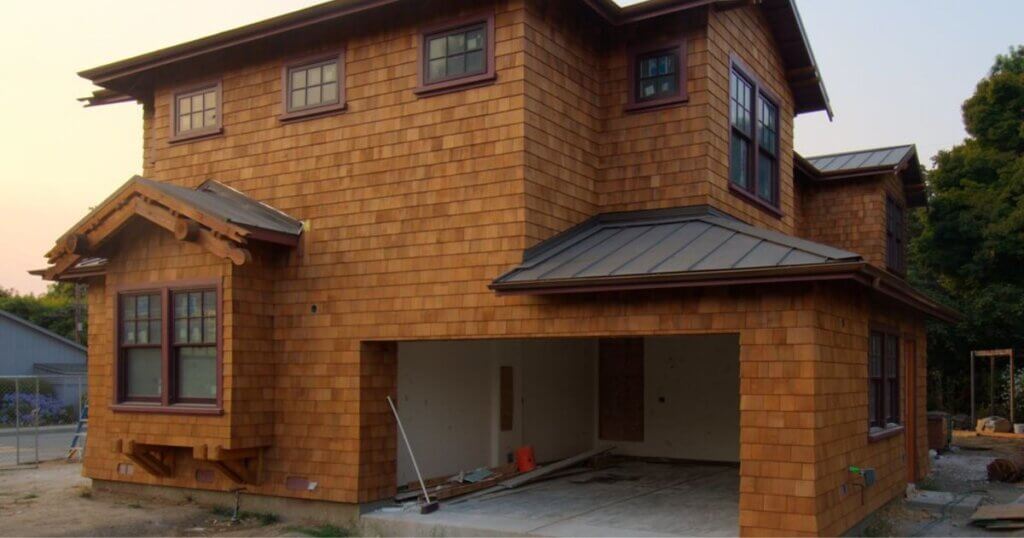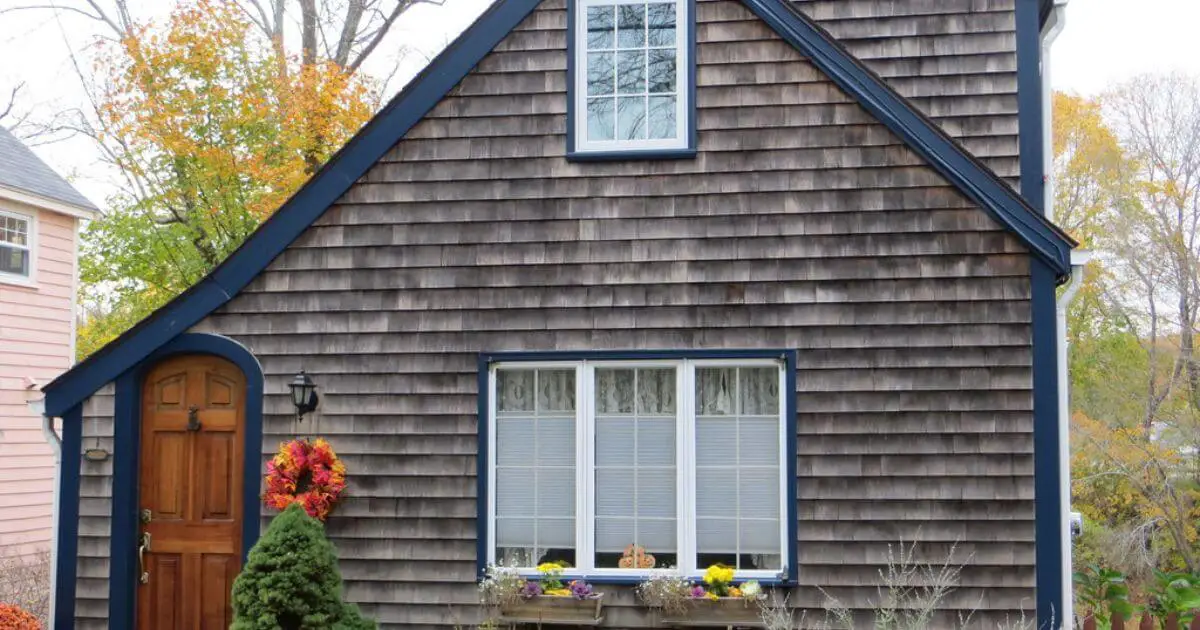Shake siding refers to a type of exterior cladding used in home construction. It is constructed into small rectangular panels that are placed next to each other to cover the entire siding. Shake siding has a more rough, rustic appearance and is thicker than shingle siding, with more texture and uneven edges.
Shakes are available in a wide range of different styles and colors, allowing you to choose ones that match your exterior. Shake siding is popular for its durability, aesthetic appeal, cost-effectiveness, and low maintenance.
What is “Cedar” Shake Siding?
In this context, “Cedar” specifically refers to the type of wood used in making the siding. Cedar wood is classified as a softwood; it comes from cedar trees and is prized for its natural durability, resistance to decay, insects, and moisture.

There are many types of cedar, but only four recognized species of cedar: Atlas cedar, Cyprus cedar, Deodar cedar, and Cedar of Lebanon. Cedar wood comes from large coniferous trees that can reach heights of 60–120 feet. These trees are native to the mountains of the western Himalayas and the Mediterranean region.
Cedar Shake Siding vs Vinyl
The main difference between cedar shake and vinyl siding is that cedar shake siding blocks are made of real wood, whereas vinyl is an engineered material made of polyvinyl chloride, also known as PVC.
Due to the difference in material, there is also a difference in texture. Vinyl shake siding does not have the texture of real wood.
Here are some other differences between Cedar Shake Siding and Vinyl:
- Cost: Cedar shake siding is more expensive than vinyl siding because it is made from real wood harvested from the forest and processed.
- Durability: Cedar shake siding is more durable and stronger than vinyl siding, making it less prone to breakage.
- Maintenance and Care: While vinyl materials have an advantage, cedar shake siding requires more care and maintenance than vinyl because wood is always prone to rot, decay, and moisture. Cedar shakes should be properly sealed and finished for outdoor use.
Pros and Cons of Cedar Shake Siding
Pros
- Natural Beauty: Cedar shake siding has a rustic, natural appearance that many homeowners find appealing. It adds warmth and character to a house.
- Durability: Cedar is naturally resistant to decay, insects, and moisture, making it a durable choice for siding. Properly maintained cedar shake siding can last for decades.
- Insulation: Cedar shakes provide natural insulation, helping to keep homes cool in the summer and warm in the winter, which can contribute to energy savings.
- Customization: Cedar shakes are available in a variety of sizes and colors, allowing for the creation of unique patterns and customized designs.
- Weather Resistance: Cedar can withstand harsh weather conditions, including wind, rain, and snow, making it suitable for various climates.
- Environmentally Friendly: Cedar is a renewable resource and biodegradable, making it an eco-friendly choice for siding.
Cons
- Maintenance: Cedar shake siding requires regular maintenance, including staining, sealing, and occasionally replacing damaged shakes. Lack of maintenance can cause issues like mold and rot.
- Discoloration: Cedar naturally turns silver-gray over time. Regular staining can maintain the original color, but it demands constant effort.
- Installation Complexity: Installing cedar shake siding demands skill and expertise, especially for proper sealing and weatherproofing. Improper installation can result in problems such as water infiltration and premature wear.
How to Maintain Cedar Shake Siding?
Proper care is essential to maintain the natural beauty and durability of cedar shake siding; it can last for many years. Here are some steps you can take to maintain cedar shake siding:
- Regular Cleaning: Regularly clear leaves, dirt, and debris from the siding to prevent mold and mildew growth. Use a pressure washer with a low-pressure nozzle to gently clean cedar shake siding. Avoid high pressure, as it can damage the siding boards. Use a mixture of mild detergent and water to clean the siding.
- Mold and Mildew Removal: If you see mold or mildew, mix water and bleach (or a commercial mold cleaner) and gently scrub the affected area. Prune bushes and trees around your home to allow sunlight and air circulation, reducing the chances of mold growth.
- Staining and Sealing: Apply a high-quality wood stain to protect the cedar from UV rays and moisture. Staining also enhances the natural color of the wood. Consider applying a clear wood sealer to provide an extra layer of protection from moisture. Reapply as needed, usually every few years.
- Regular Inspections: Regularly inspect the siding for signs of damage, such as cracks, splits, or rot. Replace damaged shakes promptly to prevent further deterioration. If you notice any significant damage, repair it right away.
By following these maintenance steps, you can extend the life of your cedar shake siding by 30 to 40% and keep your home looking beautiful for years to come.
Can You Paint Cedar Shake Siding?
Yes, you can paint Cedar Shake Siding, and I believe it is a better idea to preserve the exterior siding for a long time. Painting the exterior siding instead of staining can double its lifespan. Applying paint is easier and less expensive than staining.
First, apply a heavy, stain-resistant primer to the raw cedar, and then use exterior-grade acrylic-latex paint, which works best for cedar siding.
How Long Does Cedar Shake Siding Last?
Cedar siding generally has a lifespan of around 20-30 years, but with regular care, its lifespan can be extended even further. The durability of siding significantly depends on the grade of the wood. Inferior grade siding requires frequent maintenance and has a shorter lifespan.
How Much Does Cedar Shake Siding Cost?
On average, the cost of cedar shake roofs can range from $8.00 to $18.50 per square foot for both materials and installation.
The cost of cedar shake siding can vary depending on the grade of cedar used, the size and thickness of the boards, and styling options.

